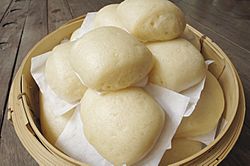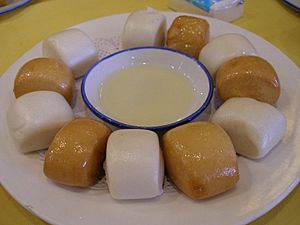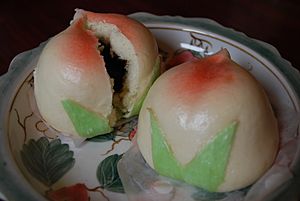Mantou facts for kids

Classic white mantou
|
|
| Alternative names | Chinese steamed bun, Chinese steamed bread |
|---|---|
| Type | Bread, dim sum |
| Place of origin | China |
| Region or state | East Asia |
| Serving temperature | Steaming hot |
| Main ingredients | Wheat flour, water, leavening agents |
| Mantou | |||||||||||||||||||||
|---|---|---|---|---|---|---|---|---|---|---|---|---|---|---|---|---|---|---|---|---|---|
| Traditional Chinese | 饅頭 | ||||||||||||||||||||
| Simplified Chinese | 馒头 | ||||||||||||||||||||
|
|||||||||||||||||||||
| Alternative Chinese name | |||||||||||||||||||||
| Traditional Chinese | 麵頭 | ||||||||||||||||||||
| Simplified Chinese | 面头 | ||||||||||||||||||||
|
|||||||||||||||||||||
Mantou (traditional Chinese: 饅頭; simplified Chinese: 馒头), often called a Chinese steamed bun, is a soft, white, and fluffy type of steamed bread. It's super popular in Northern China. People there eat it a lot! There's also a cool old story about how Mantou got its name.
Contents
What are Mantou?
Mantou are a very important food in Northern China. This is because people in Northern China grow a lot of wheat, not rice. So, Mantou are made from wheat flour, water, and special ingredients that make them rise, like yeast.
Different Kinds of Mantou
Mantou come in many sizes and textures. Some are small (about 4 cm or 1.5 inches), super soft, and fluffy. You might find these in fancy restaurants. Others are much bigger (over 15 cm or 6 inches), firm, and dense. These are often eaten by people who need a filling lunch.
Long ago, white flour was more expensive. This meant that white Mantou were a special treat!
Mantou in Chinese Meals
In Northern China, Mantou, flatbreads (called bing), and noodles were the main foods. They were like the rice that people in Southern China eat.
Even in Southern China, you can find Mantou. They are often sold as street food or in restaurants. These Mantou are usually smaller and more delicate. Sometimes, they are even deep-fried until golden. Then, people dip them in sweet condensed milk.
For special events, Mantou can be made with different colors or flavors. People might add brown sugar or food coloring. In some areas like Shanxi, Shaanxi, and Shandong, they even shape Mantou into fun designs!
Where to Find Mantou Today
You can often buy Mantou already cooked in the freezer section of Asian supermarkets. When you want to eat them, you just steam them or heat them in a microwave oven.
There's a food similar to Mantou called baozi. The difference is that baozi have a yummy savory or sweet filling inside. Mantou are usually plain. In some places, like parts of China and Korea, the word mantou can mean both filled and unfilled buns. But in Japan, the word manjū (which comes from mantou) usually means only buns with fillings.
The Story Behind the Name

Mantou might have started a very long time ago in China. It was during the Zhou Dynasty, around 307 BCE to 250 BCE. Mantou and other wheat foods like noodles became popular during the Han Dynasty (206 BCE - 206 CE). Back then, Mantou were called "steamed cakes."
Later, around 300 CE, a writer named Shu Xi wrote about these steamed cakes. He was the first to call them mantou. He even suggested eating them at a special meal in the spring.
People think that the Mongols helped spread the filled version of mantou (like baozi) to many countries. This happened around the 13th century, during the Yuan Dynasty. The name mantou is similar to words like manty and mantı. These are types of filled dumplings found in Turkish, Uzbek, and other cuisines.
The Legend of Zhuge Liang
There's a famous Chinese legend about how mantou got its name. The story says the name came from a word that sounds the same: 蠻頭 (mántóu), which means "barbarian's head."
This legend takes place during the Three Kingdoms Period (220–280 CE). Zhuge Liang was a very smart military leader. He was leading his army back from a campaign in the southern lands of Shu (which is now parts of Yunnan, China, and northern Myanmar).
They came to a fast-flowing river that they couldn't cross. A local leader told Zhuge Liang that in the past, people would sacrifice 50 men and throw their heads into the river. This was to make the river god happy so they could cross.
Zhuge Liang didn't want any more of his soldiers to die. So, he ordered his men to kill their livestock instead. They used the meat to fill buns that were shaped like human heads (round with a flat bottom). Then, they threw these buns into the river. After they successfully crossed, he named the buns "barbarian's head" (mántóu). Over time, this name changed to the modern mantou.
Another version of the story says that Zhuge Liang's soldiers got sick in the swampy area. He told them to eat steamed buns filled with meat or sweet things to help them feel better.
Mantou Names Around the World

Before the Song Dynasty (960–1279), the word mantou meant both buns with fillings and buns without fillings. But during the Song Dynasty, a new word, baozi, came about just for filled buns. So, in most of China today, mantou usually means only the plain, unfilled buns.
However, in many other places, mantou still means buns with fillings. In the Jiangnan region of China, it can mean both. In Shanxi, plain buns are often called momo. This name momo also spread to Tibet and Nepal. There, it usually means filled buns or dumplings.
The name mantou is related to manty and mantı. These are filled dumplings found in Turkish, Persian, Uzbek, and Pakistani cooking. In Japan, manjū usually means filled buns. These often have bean paste or a mix of meat and vegetables inside.
In the Philippines, filled mantou are called siyopaw. In Thailand, they are called salapao. In Korea, mandu can mean both baozi or jiaozi (another type of dumpling). In Mongolian cooking, buuz and manty are steamed dumplings. In Singapore, a fried version of mantou is often served with the famous chilli crab dish. In Nauru and Papua New Guinea, mantou are known as mãju.
See also
 In Spanish: Mantou para niños
In Spanish: Mantou para niños

